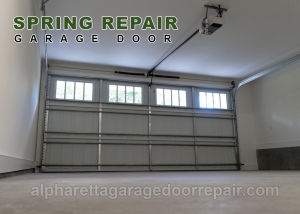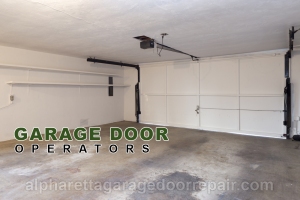Garage door springs can confuse and confound a lot of people. There are so many half-truths and non-truths “out there” that sometimes people don’t know what to believe. Alpharetta Garage Door Repair offers these tips to help you decipher all the signs and symptoms of garage door spring issues so that you can make wiser decisions concerning repair, replacement or service.
What are your springs and what do they do?
Your garage door springs are the highly pressurized metal springs that do the heavy lifting when you use your home or commercial garage door. It’s true that yo use your opener system to operate your garage door but it’s really your springs that do the actual lifting and lowering each time you access it. Springs come in two main types; torsion and extension springs.
Torsion springs are mounted horizontally over the top of the garage door while extension springs are mounted on either side of the garage door and hang above and parallel to the horizontal tracks. Both have limited life cycles and will need repair or replacement at some point depending on wear, age and use.
Torsion springs have an expected life of about 10,000 cycles. They are made of tempered and hardened steel and are built to last. Don’t forget though; the work they do is heavy and tough. Eventually, they snap or crack and when they do, they release a tremendous amount of stored energy. If you average two car trips daily, your torsion springs can last an average of about 7 years. When they break, they tend to break at about the same time so if you are replacing one, be prepared to also tend to the other. Extension springs tend to be found in older buildings and homes. They tend to last about as long as their torsion counterparts but all depends on things like humidity, use, weight of garage door, regular maintenance and other factors.
Forget DIY
DIY stands for do-it-yourself and most professionals don’t recommend that you install, repair or replace either type of garage door springs on your own. The reasons for this are many, but first and foremost is the fact that working with these highly pressurized and tempered metal springs is dangerous and not to be taken lightly. When a garage door spring breaks it releases tremendous pressure and every year many people are injured and some are even killed by improper handling of their garage door springs. Snapped springs can fly through windshields and can cause bodily injury as well as extensive property damage. All of this risk in the attempt to save a few dollars? It’s NOT worth it!
Do this check
Here’s an easy and fast check you can do on your garage door. First, make sure it’s in the down position. Then disconnect it from the opener unit by pulling down on the emergency release. If you are not sure where this is or how to do it refer to your opener’s owner’s manual or do a quick YouTube video check and you’ll find dozens of handy tutorials on how to do it.
With your garage door disconnected from the opener try lifting and lowering your door manually. Does it move smoothly and without strain or difficulty on your part? If so, your springs are most likely in good shape. If it is hard to lift or move down then your springs are probably out of balance.
Symptoms of spring damage
Did you try and operate your garage door but it fell back down on you suddenly with a loud and alarming noise?
When you operated your garage door last did it rise about 6 to 8 inches and just stop?
Did your garage door start to rise very slowly and then suddenly kick into gear and continue to lift more rapidly?
Did you hear a very loud bang when trying to operate your garage door? Sometimes they break when not in use and homeowners often think that someone is trying to break in to the house. Of course, they find no evidence of forced entry and forget about the loud noise until they try to leave for work the next day!
Does your garage door look crooked when it goes up or down? Broken extension spring
s can cause this effect as they pull independently from each other, and if one breaks; the other tries to compensate.
Your garage door looks jerky as it rises. This means that one spring broke and the other is pulling the extra weight all by itself.
You lower your garage door but instead of it going down normally, it falls very fast! This means that the garage door opener is carrying the weight of the unbalanced garage door due to one spring breaking.
You notice a gap in your torsion spring, usually about 2 inches or so wide. If you look up and notice this, one spring has snapped and the metal has recoiled enough to form the gap.
Your top portion of your garage door looks bent. This can be due to your opener unit trying to lift the garage door on its own with little help from the springs.
When you disconnected the garage door opener from the actual door by pulling the emergency release latch, was it hard to open the door by lifting it manually?
Your best bet
You are not really betting but you are encouraged to call a licensed, bonded and insured garage door repair shop that specializes in spring service. You can call our Alpharetta Garage Door Repair shop or another local firm that you like and trust. Most offer free price quotes, same day service and round the clock emergency help in case you need it. Working with the right garage door repair shop can be an affordable and time saving experience. Think about it; your time is valuable and so is your safety. Why not enjoy warranty protection, numerous safety and performance checks and superior quality springs and service by calling the professionals that handle garage door springs on a daily basis?
Article source here: Identifying Garage Door Spring Issues


